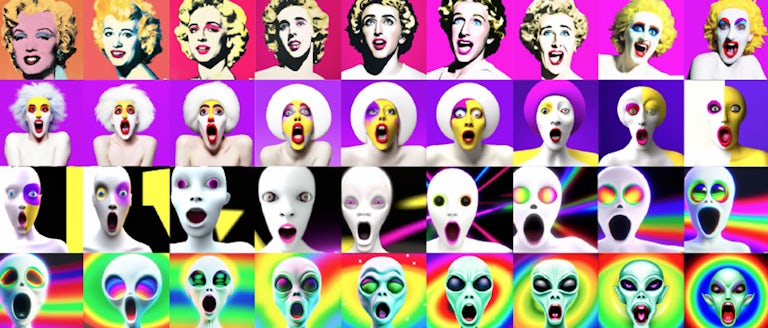Shopping Bag (0)
Your shopping bag is empty

The pop artist once said that he wanted to be a machine. What would happen if you let AI loose on one of his most celebrated works?
Every man and their dog is generating images with AI of late. You can't browse LinkedIn without wrestling through a terabyte worth of Nike concept ads or answers to groundbreaking questions that were, until now unimaginable, like what would King Henry VIII’s BeReal look like?
What's common among these significant contributions to the canon of art is that they're from the human imagination. AI generators, such as Dall-E and Midjourney, are the tools that form them. We prompt; AI makes.
I discussed this all with my housemate, software engineer Richard Cooke, and landed on this thought: what would it look like if AI had control and we removed human input?
Could we give autonomy to the machine, with no or as little input as possible? In doing so, could we glimpse at their true personalities?
This line of thinking took me back to art school, where I studied before advertising, to the work of Andy Warhol.
Our conversation reminded me of his screen prints, specifically the works where he printed the same design repeatedly.
In this work, he collaborated with the machine by not reducing the ink or experimenting with the application; different outcomes occurred.
The works developed defects that were possible only through the machine. Andy used a screen print, which didn't allow for radical change, but the thinking was there.
It was handing over control to the machine. Imagine his practice if he had his hands on AI technology. Well, we did.
We decided to use Marilyn's portrait and reproduce it through Dall-E. We asked the AI to generate variations, then variations of the variations we generated, creating a chain of reproductions that started with the portrait.
We gave the AI an image and then let it do its thing. What happened is wonderful, weird, terrifying, and eye-opening.
The images begin somewhat predictably, with generations resembling Marilyn Monroe, but then rapidly descend into the utterly weird, going from a slight resemblance to Margret Thatcher to what I’ll describe as an alien at Printworks.
And it’s only getting weirder. As we’ve observed the generations, what we’ve found most interesting is that AI image generators are reflections of us.
We train AI on images made by humans; they are machines that regurgitate our culture and history. Looking at AI art is to peer into ourselves. The reproductions make sense and no sense.
Infinite Marilyn produces images that meld so much from our culture, but in ways that are totally unpredictable.
Yet when we look back through each iteration we're witnessing the AI's thought process. There's a clear line of logic that runs between each variant
Since embarking on this project, we’ve learned a lot about AI image generators as a tool for creativity. This process has given us insight into how they think and pull unpredictable references together to create unexpected ideas.
So far, creatives have tended to use AI image generators as tools to visualise ideas, but this project has uncovered their potential as ideators in their own right.
They embody the notion of lateral thinking, fusing ideas that defy logic but when brought together are beautiful.
By giving the machine control to imagine, we’re letting it connect dots we mortals wouldn't have linked.
The possibilities are endless and, to paraphrase Lou Reed: “We have no idea where we're going.” It's a journey over which we have no control.
We’ll continue to post variants every day and gradually let this project unfold. If you’re reading this, join us, and watch as it evolves.
We called this Infinite Marilyn as we’d like this to continue forever, ideally never ending. We’re working out how to automate the process, so, in theory, it will continue to generate images without our upkeep, and continue long after we pass, giving it an unlimited time frame to come up with infinite possibilities.
With unlimited time we’d produce every possible variation of image that the AI can imagine, eventually going full circle and generating Andy Warhol’s portrait of Marilyn Monroe again.
Who knows, it could happen sooner than we think. Oh, and plot twist, I didn’t write this on Chat GPT.
Ali Munro is a creative at Amplify.
To read the full article visit Campaign.